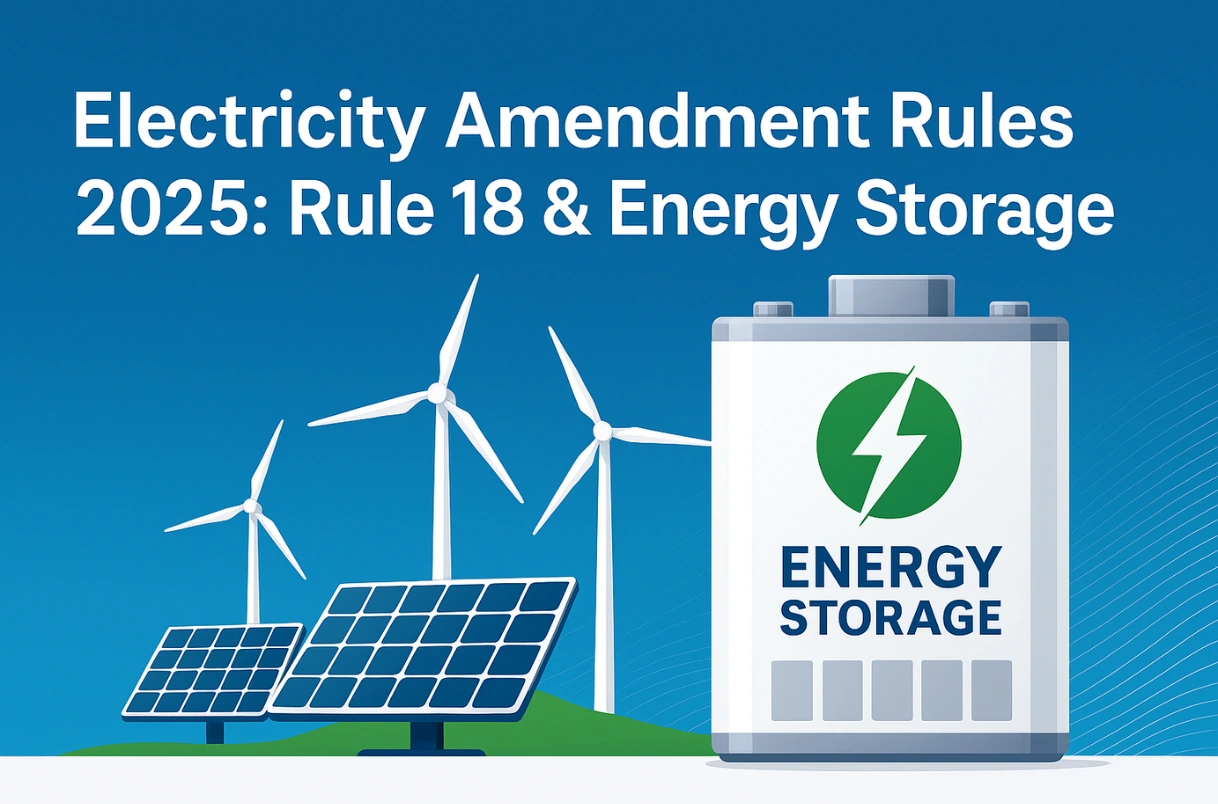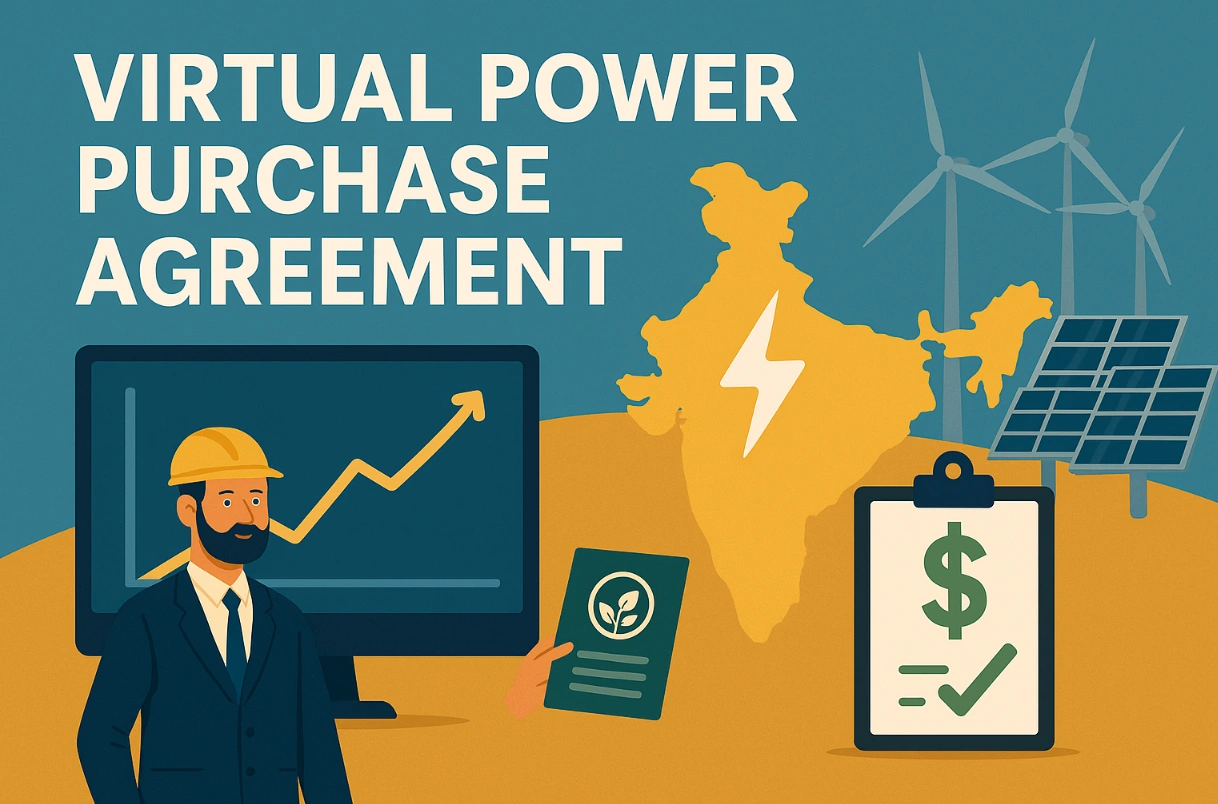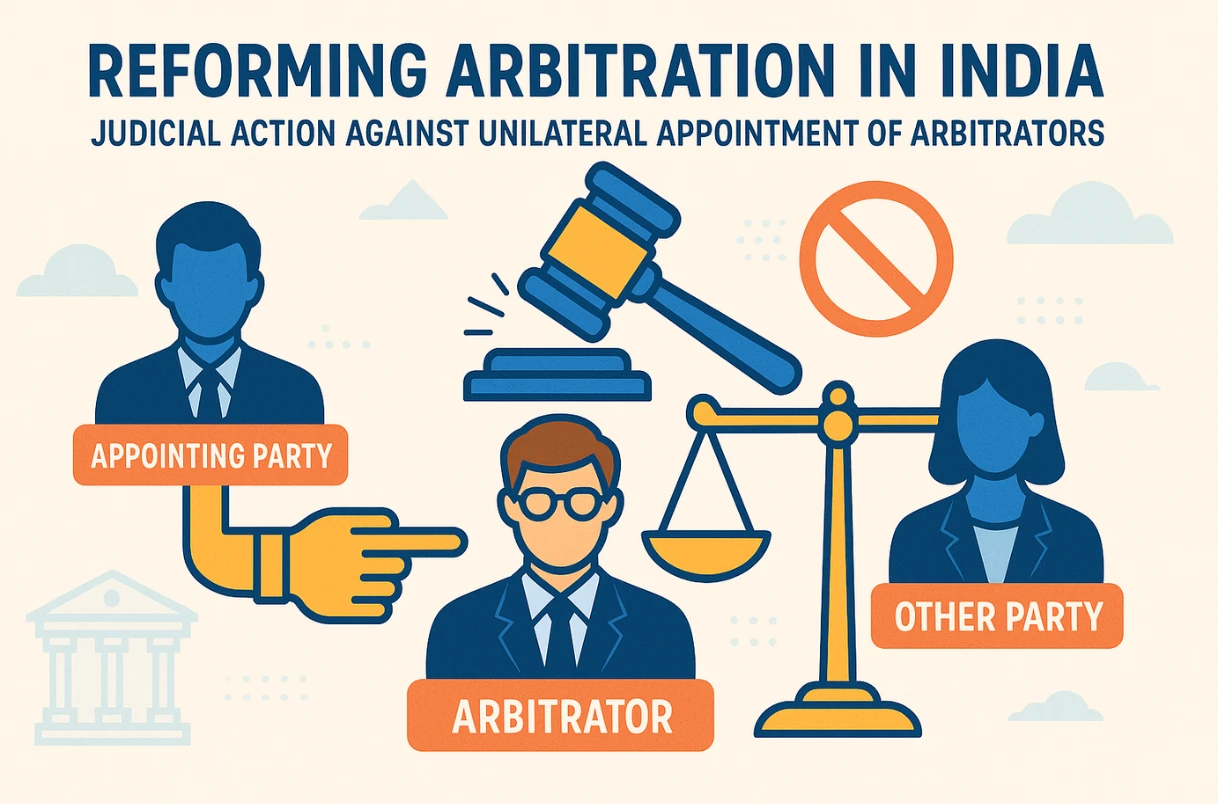Electricity Amendment Rules 2025: Rule 18 & Energy Storage

By – Devank Maheshwari and Rohan Singh
Table of Contents
Introduction
Why Energy Storage Systems (ESS) Needed Legal Recognition
For years, Energy Storage Systems (ESS) suffered regulatory neglect. Although vital to integrating renewables, ESS was undefined in law. That changed with the 2022 amendments to the Electricity Rules, 2005 (Electricity Rules), which inserted Rule 18, giving ESS recognition in the power system. Now, with the Electricity (Amendment) Rules, 2025 (2025 Amendments) notified, Rule 18 has been recast given the rapid evolution of Indian power sector. This notification, commonly referred to as the Electricity Amendment Rules 2025, marks a major step in ESS regulation. Rule 18 speaks comprehensively about what storage is, who can own it, how it is treated legally, and how it should interact with the grid.
ESS is a part of growing energy storage solutions in India. As renewable energy grows, its variability creates challenges for grid stability. ESS bridge this gap by storing surplus electricity when it is abundant and releasing it when demand peaks, effectively turning infirm renewables into firm power.
Rule 18 Today: Legal Architecture of ESS
How Energy Storage Systems Are Positioned in the Power Sector
This provision, often referred to as Rule 18 Energy Storage Systems, anchors storage firmly within India’s electricity law. Under the Electricity Rules, 20051 (“Electricity Rules”), Rule 18 (introduced via amendments in 2022) established the regulatory framework for Energy Storage Systems in India. Rule 18 clarifies where do ESS fit in the power supply chain in India. It represents one of the first comprehensive steps toward structured ESS regulation in India. As the adoption of ESS grows in India, this clarity is necessary for investment decisions as well as future regulation making.
Recognition as Part of the Power System
Mainstreaming ESS under the Electricity Act
Rule 18 begins by placing storage squarely within the ambit of the “power system” as defined under Section 2(50) of the Electricity Act, 2003 (Electricity Act). This essentially signals mainstreaming of ESS in energy infrastructure. This recognition is critical as only the elements the “power system” would fall within the jurisdiction of electricity regulators and can interact with the grid.
Modes of Use: Independent and Integrated
Flexibility in ESS Deployment Models
ESS may be deployed in two ways: independently, as a standalone facility, or integrated with generation, transmission or distribution assets. This allows maximum flexibility. This language also dispels the previous notion that ESS is merely as network support device.
Legal Status Depends on the Owner
Ownership Defines the Licensing and Treatment of ESS
Perhaps the most interesting part of Rule 18 is how it deals with the legal status of an ESS. Rather than creating a new licensing category, the rules state that storage would mirror the legal identity of its owner. If a generator owns a battery, it is part of generation. If a DISCOM owns one, it is part of distribution. If a consumer owns one, it is treated as part of that consumer’s system. And if an independent company owns a standalone ESS, it is a de-licensed generation.
This approach avoids the trappings of over-regulation of a new licensed activity. It also places well within the existing regulatory architecture.
Ownership and Operation of ESS
2025 Amendment: Inclusion of Consumers as Owners
This is where the 2025 Amendment made the most visible change. Earlier, only generating companies, transmission licensees, distribution licensees, system operators, and independent ESS providers were explicitly listed as owners and operators of ESS. Now, consumers are also added to the list. This inclusion marks a significant shift toward encouraging consumer-owned energy storage at both industrial and household levels. This is critical is it allows industrial and commercial establishments to invest in their own batteries, and paves way for household and community storage in the future. The ownership palette now stretches across the entire electricity ecosystem.
Co-located vs non-co-located ESS
How Location Affects Scheduling and Dispatch
If an ESS is co-located and operated by its owner (for instance, a solar plant with batteries on site), then the ESS is treated as part of that owner’s infrastructure. But if the ESS is not co-located, for instance, a DISCOM owning a battery, or a consumer owning a battery farm at another site, it still retains the legal identity of the owner. The catch, however, is that for scheduling and dispatch purposes, it must be treated as a separate storage element.
Commercialization of ESS Capacity
Storage-as-a-Service and Market Monetisation
Rule 18 empowers any ESS developer or owner to sell, lease, or rent out capacity, in whole or in part. The potential buyers include generators, transmission and distribution companies, load despatch centres, consumers, and even “any other person.” This provision recognizes storage-as-a-service. In fact, the concept of storage-as-a-service India could create new business models across sectors. An ESS can be sliced up and monetised across multiple users.
De-licensed but Registered
Lower Entry Barriers with Grid Visibility Requirements
Rule 18 provides that independent, standalone ESS is a de-licensed activity, just as generation. This framework underlines the growing recognition of de-licensed energy storage India as an investment opportunity. This lowers the entry barrier for investments. However, such ESS must register with the Central Electricity Authority (CEA) and have their capacity verified. This registration ensures the grid visibility.
Why the 2025 Amendments Matter
Market Structure and Investment Models
New Pathways for Investment and Participation
Rule 18 now legitimises multiple business models such as independent storage providers, DISCOM-led storage, consumer-owned batteries, and third-party leasing etc. Investors can think of batteries as assets that can be sliced and monetised.
The 2025 Amendment creates a more open and competitive market structure for energy storage. By broadening ESS ownership and usage rights to virtually all stakeholders (including consumers and independent operators), the rules envisage “democratizing participation in energy storage”. As the Electricity Rules allow storage capacity in whole or part to be traded, partial ownership or leasing arrangements can be modelled that can reduce upfront cost barriers. We may see joint ventures or leasing companies emerge that specialize in providing storage to others. It is also investment friendly as no separate license is required.
Mainstreaming Consumer-Owned ESS
From Passive Buyers to Active Energy Managers
However, the most important change is the recognition of Consumers as the owners of ESS. Industrial and commercial consumers have long been dependent on diesel generators or costly peak power. Now, they can directly own storage. They can arbitrage tariffs, firm up rooftop solar, or even lease capacity to others.
This also means that large consumers can invest in captive ESS projects, either on-site or even at a remote location, to manage their energy needs. In practice, some consumers might shift from passive buyers to active power managers, altering traditional load profiles. This decentralization of energy resources follows the trend seen with rooftop solar and can usher in specialized forms of renewable energy storage systems.
Impact on Utilities and Grid Stability with BESS
Evolving Roles for DISCOMs, Generators, and Grid Operators
This part of the Electricity Amendment Rules 2025 highlights the importance of grid stability with ESS in managing variability from renewables. Generators and DISCOMs still retain the right to own and use storage, but they will now operate in a more competitive ecosystem. If consumers start managing peaks on their own, DISCOMs’ revenue models will shift. We are increasingly seeing bundling of storage with supply. Similarly, grid operators will need to evolve scheduling and dispatch protocols for ESS. As fleets of batteries are being established, the recognition that storage is a separate dispatchable element becomes even more critical.
It promotes a grid where many nodes can simultaneously generate, consume, and store energy. This aligns with the broader renewable energy storage policy India is shaping to integrate distributed resources. This is in line with global trends of moving toward Distributed Energy Resources (DER) integration. In fact, by empowering “prosumers” with storage, India is taking a step toward the concept of virtual power plants and aggregated supply models, which can aggregate many small resources to act like a big power plant, for ease of grid interaction. This reflects the emergence of consumer prosumers energy storage in the Indian market landscape.
Regulatory Recognition
Operational Questions Still Await Clarity
The regulations might have been clarified, but the process has just begun. The law de-licenses storage, but regulators still must sort out the plumbing- metering, settlement, deviation charges, open access treatment etc. There are still a lot of questions looming, those presumably will be ironed out at the level of Appropriate Commission. For instance, will the consumer owned off site storage require new banking rules? How will regulators handle multi-use storage (part regulated, part commercial) in accounting and tariffs? The Electricity Rules have set the base, but the operational regulations must catch up. If a Load Despatch Centre operates a battery, perhaps to maintain grid frequency, who approves that investment or expense?
Conclusion
The broader renewable energy storage policy India context shows how consumer-owned and de-licensed storage is becoming integral to electricity law. The 2025 Amendment may not have massively hit the headlines, but it quietly recasted the place of ESS in electricity law. Where storage was once seen as an adjunct, it is now a consumer resource, tradable service/ product, apart from being essential for grid stability, given the growth trajectory of renewables. With massive integration of ESS incoming, regulators, DISCOMs, and markets, generally, must adapt quickly to make ESS work. By updating Rule 18, especially with the inclusion of consumers and the flexibility in usage models, we have formally acknowledged energy storage as a key piece of modern power systems, while creating a more enabling environment for its deployment.
FAQs
-
What is Rule 18 under the Electricity Amendment Rules 2025?
Rule 18, recast through the Electricity Amendment Rules 2025, provides a comprehensive legal framework for Energy Storage Systems (ESS). It defines their role in the power system, clarifies ownership, and sets the ground for their integration with generation, transmission, distribution, and consumer use.
-
How do the 2025 Rules recognize Energy Storage Systems (ESS)?
The Rules formally place ESS within the definition of the “power system” under the Electricity Act, 2003. This recognition mainstreams ESS, bringing them under the jurisdiction of electricity regulators and ensuring they are treated as integral infrastructure for grid stability and renewable integration.
-
Who can own and operate ESS after the 2025 amendments?
Ownership has been broadened beyond generating companies, transmission licensees, distribution licensees, system operators, and independent ESS providers. Consumers are now explicitly recognized as potential owners and operators, opening the door for industrial, commercial, and even household-level participation in energy storage.
-
What is the legal status of consumer-owned ESS in India?
Consumer-owned ESS mirrors the identity of the owner. If a consumer owns storage, it is treated as part of the consumer’s system. This allows them to manage peak demand, firm up rooftop solar, or even lease storage capacity to others, shifting their role from passive buyers to active “prosumers.”
-
Are standalone ESS projects a licensed activity?
No. Standalone ESS projects are treated as a de-licensed activity, much like power generation. However, independent ESS operators must register with the Central Electricity Authority (CEA) for capacity verification, ensuring grid visibility and regulatory oversight without creating licensing barriers.
-
Can ESS capacity be leased or sold to third parties?
Yes. Rule 18 empowers ESS developers and owners to sell, lease, or rent out storage capacity wholly or partly. Potential buyers include generators, DISCOMs, consumers, load despatch centres, and even third parties. This framework effectively enables a “storage-as-a-service” model in India.
-
What changes were made to co-located vs non-co-located ESS?
If ESS is co-located with its owner’s asset, it is treated as part of that asset’s infrastructure. If it is non-co-located, it retains the legal status of its owner but, for scheduling and dispatch, must be treated as a separate storage element, ensuring proper grid coordination.
-
Why is consumer participation in ESS a game changer?
Consumer participation allows industries and households to reduce reliance on diesel generators or costly peak power. It enables tariff arbitrage, rooftop solar integration, and even leasing of capacity, fostering decentralised renewable energy storage and creating a new class of active energy managers in India’s electricity system.
-
How does Rule 18 impact grid stability and renewable integration?
By formally recognising ESS as dispatchable elements, Rule 18 strengthens grid stability in the face of variable renewable generation. It supports balancing supply and demand, promotes distributed storage models, and aligns with India’s renewable energy storage policy for integrating distributed resources and virtual power plant concepts.
-
What regulatory issues remain unresolved under the 2025 Rules?
While Rule 18 sets the framework, several operational questions remain—such as metering, settlement, deviation charges, treatment of multi-use storage, and banking rules for off-site consumer-owned ESS. These details are left to appropriate commissions and will shape how effectively ESS markets function in practice.


